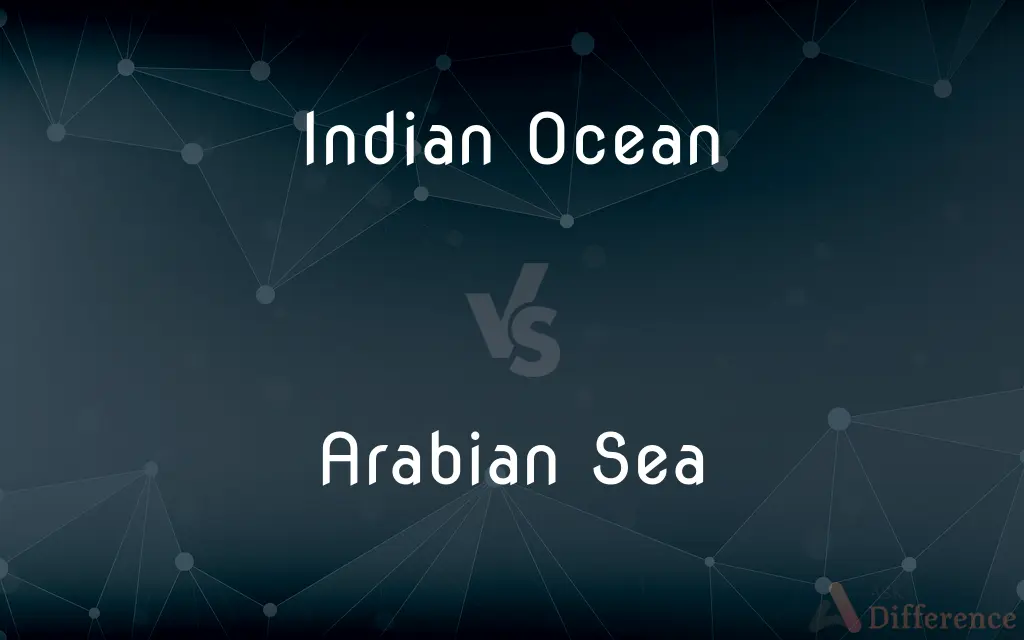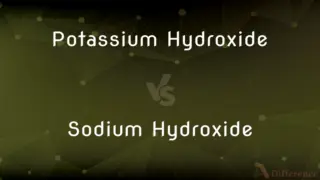Indian Ocean vs. Arabian Sea — What's the Difference?
By Tayyaba Rehman — Published on November 5, 2023
The Indian Ocean is the third-largest ocean globally, while the Arabian Sea is its northwestern part.

Difference Between Indian Ocean and Arabian Sea
Table of Contents
ADVERTISEMENT
Key Differences
The Indian Ocean is a vast body of water, constituting one of the world's major oceans, encompassing a broad expanse that stretches from Africa to Australia. The Arabian Sea, on the other hand, is a significant component of the Indian Ocean, situated between the Indian subcontinent and the Arabian Peninsula.
The Indian Ocean has a variety of seas and gulfs within its boundaries, one of which is the Arabian Sea.
Both the Indian Ocean and Arabian Sea play essential roles in maritime trade and have significant ecological, historical, and cultural significance. The Arabian Sea, being a part of the Indian Ocean, has its unique characteristics and distinctions, including its boundaries, depth, and maritime significance.
However, when talking about scale, the Indian Ocean is substantially larger and more extensive than the Arabian Sea.
Comparison Chart
Location
Global; between Africa, Asia, Australia, & Antarctica
Part of Indian Ocean; between India and Arabian Peninsula
ADVERTISEMENT
Size
Third-largest ocean in the world
A sea within the Indian Ocean
Importance
Facilitates major global maritime routes
Critical for trade between India, Middle East, & Africa
Depth
Average depth of about 12,080 feet
Deeper towards its southern side, shallower in the north
Boundaries
Bounded by four continents
Bounded mainly by the coasts of India, Oman, and Yemen
Compare with Definitions
Indian Ocean
Home to numerous islands, including Madagascar and the Maldives.
Madagascar, located in the Indian Ocean, boasts unique biodiversity.
Arabian Sea
Home to several important ports, including Mumbai and Karachi.
Mumbai's port on the Arabian Sea is one of India's busiest.
Indian Ocean
An essential component of the Earth's climatic system.
The Indian Ocean's monsoon winds influence the climate of several Asian countries.
Arabian Sea
Known for its importance in regional trade and commerce.
Trade routes in the Arabian Sea have been active for centuries, linking various civilizations.
Indian Ocean
The third-largest ocean on Earth.
The Indian Ocean is warmer than the Atlantic and Pacific Oceans.
Arabian Sea
Influences the climate of the surrounding regions, especially the monsoons.
The onset of the monsoon in India is significantly impacted by the temperature of the Arabian Sea.
Indian Ocean
A vast oceanic body between Africa, Asia, Australia, and Antarctica.
The Indian Ocean offers some of the world's most beautiful beaches.
Arabian Sea
Located between the Indian subcontinent and the Arabian Peninsula.
The Arabian Sea sees a significant amount of maritime traffic due to its strategic location.
Indian Ocean
A major route for maritime trade and transportation.
Many shipping lanes cross the Indian Ocean, linking the East to the West.
Arabian Sea
A sea within the northwestern part of the Indian Ocean.
The Arabian Sea provides a coastline to countries like India and Oman.
Common Curiosities
Where is the Arabian Sea located?
The Arabian Sea is located in the northwestern part of the Indian Ocean, between the Indian subcontinent and the Arabian Peninsula.
Does the Indian Ocean have other seas within it besides the Arabian Sea?
Yes, the Indian Ocean contains several seas, including the Red Sea, Andaman Sea, and Persian Gulf, to name a few.
Are there any significant islands in the Arabian Sea?
Yes, the Lakshadweep Islands in India and the Socotra Island belonging to Yemen are in the Arabian Sea.
What is the Indian Ocean?
The Indian Ocean is the third-largest ocean in the world, situated between Africa, Asia, Australia, and Antarctica.
What are the primary countries bordering the Arabian Sea?
The primary countries bordering the Arabian Sea are India, Pakistan, Oman, Yemen, and parts of Iran and UAE.
How does the size of the Indian Ocean compare to the Arabian Sea?
The Indian Ocean is much larger, while the Arabian Sea is just a component of it.
What historical importance does the Indian Ocean hold?
The Indian Ocean has been a vital route for trade, cultural exchange, and maritime exploration for centuries, connecting civilizations from Asia, Africa, and the Middle East.
Why is the Arabian Sea of strategic importance to the Middle East and India?
The Arabian Sea provides access to major ports like Mumbai and Karachi, facilitating regional trade, commerce, and military naval operations.
What is the deepest point in the Arabian Sea?
The deepest point in the Arabian Sea is the Sunda Trench, which reaches depths of about 7,450 meters.
Are there significant marine life differences between the Indian Ocean and the Arabian Sea?
While both the Indian Ocean and the Arabian Sea support diverse marine life, the specific species and their concentrations might differ due to varying conditions like water temperature, salinity, and depth.
Does the Indian Ocean have any unique geographical features?
Yes, the Indian Ocean has the underwater Mascarene Plateau, the world's largest undersea plateau, and the Maldives, the lowest country in terms of average ground level.
What role do the Indian Ocean and the Arabian Sea play in global climate patterns?
Both the Indian Ocean and the Arabian Sea play crucial roles in influencing global climate systems, notably through ocean currents, temperature variations, and their effect on monsoons and other weather patterns.
How do the monsoons relate to the Indian Ocean and the Arabian Sea?
The monsoons, seasonal winds in South and Southeast Asia, are significantly influenced by the temperature and currents of the Indian Ocean and the Arabian Sea, impacting rainfall patterns.
Are there any endangered species unique to the Indian Ocean or the Arabian Sea?
Both the Indian Ocean and the Arabian Sea are home to various species, some of which, like the Dugong in the Indian Ocean or the Arabian Sea humpback whale, are considered vulnerable or endangered.
How does the salinity of the Arabian Sea compare to that of the larger Indian Ocean?
The Arabian Sea generally has higher salinity compared to the broader Indian Ocean due to high evaporation rates, lesser freshwater inflow, and limited connection to open waters.
Share Your Discovery

Previous Comparison
Potassium Hydroxide vs. Sodium Hydroxide
Next Comparison
Partly Cloudy vs. Mostly SunnyAuthor Spotlight
Written by
Tayyaba RehmanTayyaba Rehman is a distinguished writer, currently serving as a primary contributor to askdifference.com. As a researcher in semantics and etymology, Tayyaba's passion for the complexity of languages and their distinctions has found a perfect home on the platform. Tayyaba delves into the intricacies of language, distinguishing between commonly confused words and phrases, thereby providing clarity for readers worldwide.















































